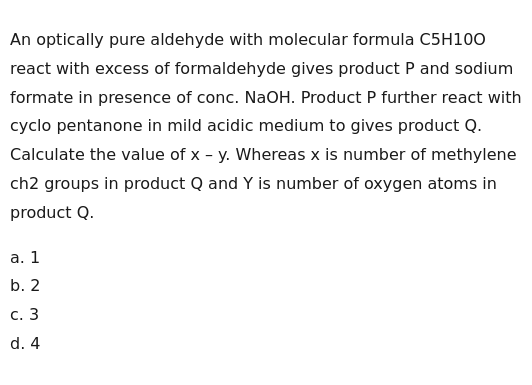Question
Question: An optically pure aldehyde with molecular formula C5H10O react with excess of formaldehyde gives pro...
An optically pure aldehyde with molecular formula C5H10O react with excess of formaldehyde gives product P and sodium formate in presence of conc. NaOH. Product P further react with cyclo pentanone in mild acidic medium to gives product Q. Calculate the value of x – y. Whereas x is number of methylene ch2 groups in product Q and Y is number of oxygen atoms in product Q.

4
Solution
Step 1: Identify the optically pure aldehyde (C5H10O)
The molecular formula C5H10O corresponds to saturated aldehydes or ketones. For an aldehyde to be optically pure, it must have a chiral carbon atom. Let's examine the possible aldehyde structures:
- Pentanal (CH3CH2CH2CH2CHO): No chiral carbon.
- 3-Methylbutanal ((CH3)2CHCH2CHO): No chiral carbon.
- 2-Methylbutanal (CH3CH2CH(CH3)CHO): The carbon at position 2 is bonded to -H, -CH3, -CH2CH3, and -CHO groups. This carbon is chiral.
- 2,2-Dimethylpropanal ((CH3)3CCHO): No alpha hydrogen, no chiral carbon.
Therefore, the optically pure aldehyde is 2-Methylbutanal.
Step 2: Determine product P from the reaction of 2-Methylbutanal with excess formaldehyde in conc. NaOH
2-Methylbutanal has one alpha hydrogen. In the presence of strong base (conc. NaOH) and excess formaldehyde (which has no alpha hydrogens and is very reactive), a crossed aldol condensation occurs first, followed by a crossed Cannizzaro reaction.
The alpha hydrogen of 2-Methylbutanal is removed by the base to form an enolate: CH3CH2CH(CH3)CHO OH− CH3CH2C−(CH3)CHO
The enolate attacks the carbonyl carbon of formaldehyde: CH3CH2C−(CH3)CHO + HCHO → CH3CH2C(CH3)(CH2O−)CHO H2O CH3CH2C(CH3)(CH2OH)CHO This product is 2-(hydroxymethyl)-2-methylbutanal. It has no alpha hydrogens.
In the presence of excess formaldehyde and concentrated base, this aldehyde undergoes a crossed Cannizzaro reaction. Formaldehyde is oxidized to formate, and the 2-(hydroxymethyl)-2-methylbutanal is reduced to the corresponding alcohol. CH3CH2C(CH3)(CH2OH)CHO HCHO,conc.NaOH CH3CH2C(CH3)(CH2OH)CH2OH + HCOONa The product P is 2-(hydroxymethyl)-2-methylbutan-1-ol. Its molecular formula is C6H14O2.
Step 3: Determine product Q from the reaction of P with cyclopentanone in mild acidic medium
Product P is a diol: CH3CH2-C(CH3)-(CH2OH)2. Diols react with ketones in mild acidic conditions to form cyclic ketals. The two hydroxyl groups of the diol react with the carbonyl group of the ketone, eliminating water.
The two -CH2OH groups in P react with the carbonyl carbon of cyclopentanone to form a cyclic ketal. The structure of Q is a spiro compound where the spiro carbon is the ketal carbon originating from cyclopentanone. One ring is the cyclopentane ring (5 carbons). The other ring is formed by the two oxygen atoms from P, the two CH2 groups attached to these oxygens, and the carbon atom (C*) from P to which these CH2 groups are attached. This forms a 6-membered ring (-O-CH2-C*-CH2-O-Cketal-). The carbon C* is bonded to a CH3 group and a CH2CH3 group.
Let's visualize the structure of Q: The central carbon (C*) from P is bonded to CH3, CH2CH3, and two -CH2- groups. These two -CH2- groups are part of a 6-membered ring formed by linkage through oxygen atoms to the ketal carbon (Cketal). Cketal is also part of the 5-membered cyclopentane ring.
Structure of Q:
O----CH2
/ |
C_k-- C*(CH3)(CH2CH3)
\ |
O----CH2
|
(Cyclopentane ring)
Ck is the spiro carbon. It is bonded to two oxygen atoms and two carbons of the cyclopentane ring. C* is bonded to two CH2 groups (in the ring), a CH3 group, and a CH2CH3 group.
Step 4: Calculate x (number of methylene CH2 groups in Q)
Methylene groups (CH2) in Q are located:
- Within the 6-membered ring: There are two CH2 groups (-O-CH2-C*-CH2-O-).
- Within the 5-membered cyclopentane ring: The cyclopentane ring has 5 carbons. One carbon is the spiro carbon (Ck), which is quaternary. The other four carbons are methylene groups (-CH2-)4. Total number of methylene groups (x) = 2 (from 6-membered ring) + 4 (from cyclopentane ring) = 6.
Step 5: Calculate y (number of oxygen atoms in Q)
The ketal structure contains two oxygen atoms, originating from the diol P. Total number of oxygen atoms (y) = 2.
Step 6: Calculate x - y
x - y = 6 - 2 = 4.
